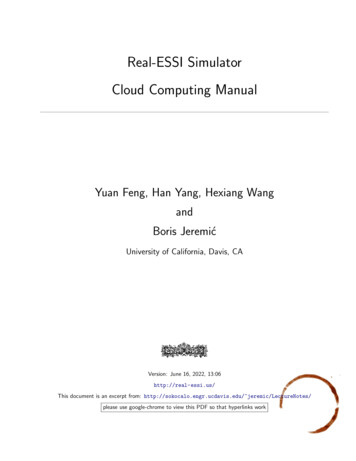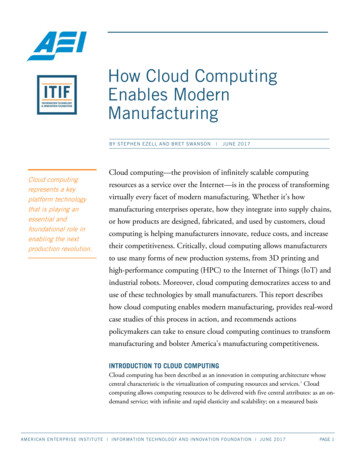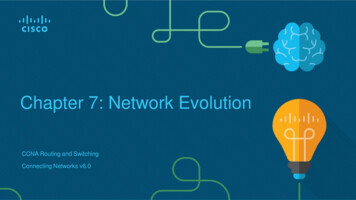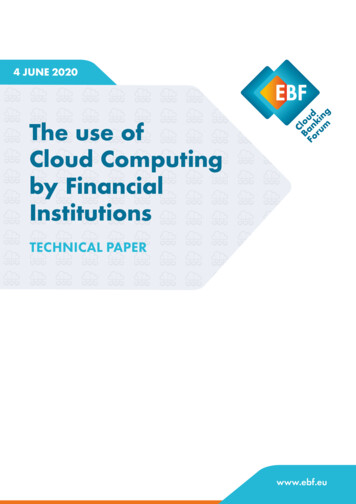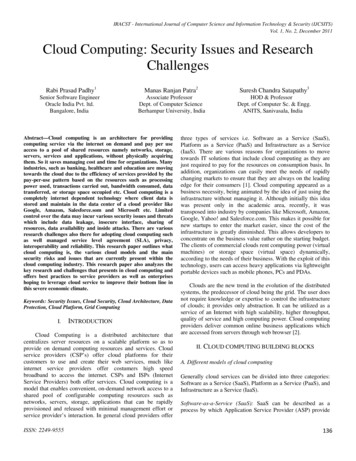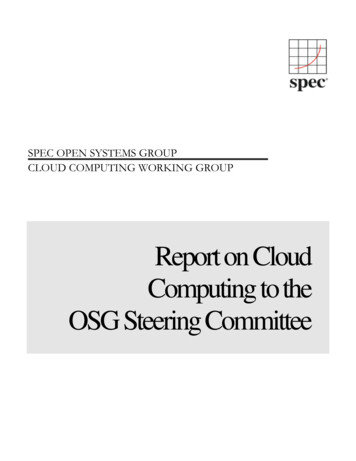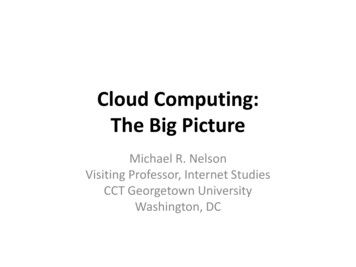
Transcription
Presenting a live 90-minute webinar with interactive Q&ACloud Computing: E-Discovery ChallengesBest Practices to Minimize Pitfalls in Identification, Preservation and Collection of ESIWEDNESDAY, OCTOBER 24, 20121pm Eastern 12pm Central 11am Mountain 10am PacificToday’s faculty features:Todd Nunn, Partner, K&L Gates, SeattleTanya Forsheit, Partner, Information Law Group, Manhatten Beach, Calif.The audio portion of the conference may be accessed via the telephone or by using your computer'sspeakers. Please refer to the instructions emailed to registrants for additional information. If youhave any questions, please contact Customer Service at 1-800-926-7926 ext. 10.
Sound QualityIf you are listening via your computer speakers, please note that the quality ofyour sound will vary depending on the speed and quality of your internetconnection.If the sound quality is not satisfactory and you are listening via your computerspeakers, you may listen via the phone: dial 1-866-869-6667 and enter yourPIN -when prompted. Otherwise, please send us a chat or e-mailsound@straffordpub.com immediately so we can address the problem.If you dialed in and have any difficulties during the call, press *0 for assistance.Viewing QualityTo maximize your screen, press the F11 key on your keyboard. To exit full screen,press the F11 key again.
FOR LIVE EVENT ONLYFor CLE purposes, please let us know how many people are listening at yourlocation by completing each of the following steps: In the chat box, type (1) your company name and (2) the number ofattendees at your location Click the SEND button beside the box
If you have not printed the conference materials for this program, pleasecomplete the following steps: Click on the sign next to “Conference Materials” in the middle of the lefthand column on your screen. Click on the tab labeled “Handouts” that appears, and there you will see aPDF of the slides for today's program. Double click on the PDF and a separate page will open. Print the slides by clicking on the printer icon.
Cloud Computing and E-DiscoveryTodd L. Nunne-Discovery Analysis and Technology Group, K&L Gates, Seattle206.370.7616todd.nunn@klgates.com
Cloud Computing E-Discovery - Contents Cloud Computing IntroductionPossession, Custody and ControlLitigation Holds/26(f) Conference/CollectionUse and AdmissibilityJurisdictionThird-party Subpoenas6
What is Cloud Computing? “Cloud computing comes into focus only when you thinkabout what IT always needs: a way to increase capacityor add capabilities on the fly without investing in newinfrastructure, training new personnel, or licensing newsoftware. Cloud computing encompasses anysubscription-based or pay-per-use service that, in realtime over the Internet, extends IT’s existing capabilities.” Knorr, Galen, “What cloud computing really means”, Infoworld (4/7/2008)7
What is Cloud Computing? “The very definition of cloud computing remainscontroversial. Consulting firm Accenture has crafted auseful, concise definition: the dynamic provisioning of ITcapabilities (hardware, software, or services) from thirdparties over a network.” “Cloud computing is a computing model, not atechnology.” Fogarty, “Cloud Computing Definitions and Solutions”, CIO.com(9/10/2009).8
Types of Cloud Computing Services - NIST Cloud Software as a Service (SaaS) Use provider’s applications over a network Cloud Platform as a Service (PaaS) Deploy customer-created applications to a cloud Cloud Infrastructure as a Service (IaaS) Rent processing, storage, network capacity, andother fundamental computing resources9
The NIST Cloud Definition FrameworkHybrid rivateCloudSoftware as aService (SaaS)Public CloudPlatform as aService (PaaS)Infrastructure as aService (IaaS)On Demand risticsBroad Network AccessRapid ElasticityResource PoolingMeasured ServiceMassive ScaleResilient ComputingHomogeneityGeographic DistributionVirtualizationService OrientationLow Cost SoftwareAdvanced Security1010
Advantages of Cloud Computing Lower Costs Reduce owned infrastructure Reduce personnel Increase Computing Capabilities Large scale storage/massive processing Flexibility – rapid deployment Specialized tools/applications/services Solves Problems Technology on demand11
Disadvantages of Cloud Computing - Control Bottom line – Third party has data Loss of physical controlSecurity – Access restriction/controlAuditability – visibilityForensic access Still responsible legally for data handling Still legally in control Discovery obligations Regulatory compliance12
Disadvantages of Cloud Computing – Cloudiness Who has data Cloud service providerData center providerMore parties – backup provider – consultantsFinancial viability - Robust systems Where is data Multiple providers Different states/countries How is it being handled Co-mingling with other customer’s data Backup policy/retention Permissions/Export/Transfer13
Cautionary Tale: Liquid Motors, Inc. v. Lynd,No.3:09-cv-0611-N (N.D. Tex. April 3, 2009) FBI executed search warrant, raided LiquidMotors (LM) building, seized all equipment LM was not suspected of any wrongdoing Seizure and removal of equipment prevented LM fromconducting business – LM clients who relied on thehosting service also suffered interruption LM applied for temporary restraining order and return ofequipment Court found probable cause for FBI’s retention ofequipment, denied application, ordered storage arrayreturned within three days (after being copied), ordered“other servers” and second storage array copied andreturned to LM “as soon as possible”14
Questions to ask Cloud Provider – as a start Will my data be in the same database as other customers? Will you commit to segregating our company data How do you deal with differences in retention periodsbetween customers? When you perform backups, will my data be co-mingled withthe data from other companies on the same tape? What is your retention period for your backup tapes? When backup tapes reach the end of the retention period,how many months is it before you re-use them? Where will my data reside? Will you commit to a set location Can you provide me information of data center provider15
Possession,Custody, Control16
Possession, Custody and Control Under Rule 34, Control does not require that the partyhave legal ownership or actual physical possession ofthe documents at issue. Documents are considered to be under a party’s controlwhen that party has the right, authority, or practicalability to obtain the documents from a non-party to theaction. A contract about document handling is sufficient toestablish party control over documents in thepossession of a third party.17
Possession, Custody and Control With material in cloud, no physical custody, butlegal control Legal control in form of agreement/contract forcloud services Irony is that you could have legal control (orentitlement), but might not have “practical ability” toget documents Contract should spell out precisely how get and whopays Must understand how data is stored to avoidsurprises since you are legally in “control”18
Preservation19
Zubulake: Preservation Standard “Once a party reasonably anticipates litigation, it mustsuspend its routine document retention/destructionpolicy and put in place a ‘litigation hold’ to ensure thepreservation of relevant documents.” Zubulake v. UBSWarburg, LLC, 229 F.R.D. 422, 431 (S.D.N.Y. 2004).“The obligation to preserve evidence arises when theparty has notice that the evidence is relevant tolitigation or when a party should have known that theevidence may be relevant to future litigation.” Zubulakev. UBS Warburg LLC, 220 F.R.D. 212 (S.D.N.Y. 2003)20
Legal Holds Start with Document Retention Policy Understand Policy v. Practice Coordinate with Records Manager or IT Whom do you tell? “Key” Custodians Data Stewards: Including Cloud Providers Evolving Process Revisit at Critical Stages21
Legal Holds How do you tell them? In Writing Depends on Culture What do you tell them? Describe the Case Document Categories Instructions for Technical Handling Consequences/Contact Information Follow up Follow up Notices Interviews22
Cyntegra, Inc. v. Idexx Labs., Inc., 2007 WL5193736 (C.D. Cal. Sept. 21, 2007) Data stored on third-party’s server was deletedwhen Plaintiff failed to make payments Defendant moved for spoliation sanctions Among other things, Plaintiff alleged it did not havecontrol of the documents for purpose ofpreservation23
Cyntegra, Inc. v. Idexx Labs., Inc., Cont.“Similarly, Plaintiff had sufficient control and legal right over thedeleted files to constitute fault. Plaintiff contracted to storebusiness documents on NetNation’s computer servers. At leastuntil March 7, 2006, when payment was discontinued, Plaintiffcould direct the flow of information to and from NetNation’sservers. Because Plaintiff could have anticipated the possibilityof litigation by this time, it had an affirmative duty to makepayments and preserve the evidence. Plaintiff cannot bypassthis duty by abandoning its documents to a third-party andclaiming lack of control. . . . A contractual relationship with athird-party entity provides, at a minimum, an obligation to makereasonable inquiry of the third party entity for the data at issue.”24
Legal HoldsLet’s CloudThe IssueDocument management/Litigation response plan must take cloud services intoaccountTalk to custodians about what they use/how they storeContract with Cloud provider should be specific about how legal holds will behandled/charged Specific of how any deletion will be discontinued How handle preservation of your data, while handling co-mingled data Must understand retention periods, back up practices, co-mingling of data,redundancy of systems, security practices of cloud provider Provider failing or being taken off line during preservation period could be found to bespoliation Preservation periods could be years long, how maintain/transfer Legacy ESI25
Federal Rule 26(f) “In conferring the parties must discuss any issuesabout preserving discoverable information ” 26(f) Advisory Committee Notes discussion of ESI will involve nature of parties’information systems “It may be important for the parties to discuss thosesystems, and accordingly important for counsel tobecome familiar with those systems before theconference.”26
Federal Rule 26(f) Advisory Committee Notes Reasonableness should guide preservation efforts “The parties’ discussion should pay particularattention to the balance between the competingneeds to preserve relevant evidence and to continueroutine operations critical to ongoing activities.” Recommends parties’ goal should be to agree to“reasonable preservation steps” taking allconsiderations into account27
Rule 26(f) ConferencesLet’sCloudThe Issue Due diligence to understand how cloud provider isstoring data Must understand cloud provider system to meetrequirements of 26(f) If problematic features (slow collection, changemetadata, failed or lost data or provider), shouldflag in conference28
Inaccessible data – FRCP 26(b)(2)(B) Specific Limitations on Electronically Stored Information. Aparty need not provide discovery of electronically storedinformation from sources that the party identifies as notreasonably accessible because of undue burden or cost.On motion to compel discovery or for a protective order,the party from whom discovery is sought must show thatthe information is not reasonably accessible because ofundue burden or cost. If that showing is made, the courtmay nonetheless order discovery from such sources if therequesting party shows good cause, considering thelimitations of Rule 26(b)(2)(C). The court may specifyconditions for the discovery.29
Inaccessible data – FRCP 26(b)(2)(B) Advisory Committee Notes: “A party’s identificationof sources of [ESI] as not reasonably accessibledoes not relieve the party of its common-law orstatutory duties to preserve evidence. Whether aresponding party is required to preserveunsearched sources of potentially responsiveinformation that it believes are not reasonablyaccessible depends on the circumstances of eachcase. It is often useful for the parties to discuss thisissue early in discovery.”30
Calixto v. Watson Bowman Acme Corp., 2009 WL3823390 (S.D.Fla. 2009) Defendant argued backup tapes were inaccessible becauseof undue burden or cost Vendor estimate for restoring and searching: 40,000 allexpense to review for relevance and privilege Found inaccessible No “good cause” found because material likely duplicativegiven time frame and evidence of defendant’s preservation But one backup tape from earlier time period found notinaccessible because cost of restoring and reviewing onetape not burdensome, and evidence of no duplication ofmaterial31
Starbuck’s v. ADT Security Services, 2009 WL 4730798(W.D. Wash.) Used a Zantaz e-mail archive system for certain timeperiod –Plasmon System 500 double sides DVDs accessed by a robot arm Very slow and laborious to retrieve – but still in use ADT argued that archive was inaccessible Court held archive not inaccessible Court did not find time or expense estimates credible Because still in use – held must be accessible Cannot relieve party of duty to produce those documentsmerely because has chosen a means to preserve whichmakes ultimate production of documents expensive32
Inaccessible DataLet’sCloudThe Issue Burden is on data owner to show inaccessibility Agreement should be specific about costs for litigationsupport Not inaccessible just because ESI hard/expensive to get Must understand what cloud provider has and how it works tosupport argument of inaccessibility Arguments that data is redundant Support specific arguments regarding expense33
Collection34
Collection of ESI Collect by custodian Full collection Self collection Collect by search terms Sweep and keep systems File shares Non-custodial sources Databases Cloud sources Preservation of metadata and filestructure35
CollectionLet’sCloudThe Issue Ability to collect completely as important under federal case law Understand where data is stored Need to be able to identify custodian material and track what iscollected Speed of collection Collection in bulk or custodian-by-custodian/document-by-document Format - does cloud storage change metadata What metadata is provided Will provider be able to prove nothing was deleted - audit36
Authentication37
Procedure of Authentication Authenticity under 104(b) Judge makes preliminary determination Based on admissible evidence Sufficient evidence to support a jury finding of relevance Court need not find that the evidence is necessarily what theproponent claims, but only that there is sufficient evidencethat the jury ultimately might do so38
Authentication Evidence rules on authentication apply to ESI in thesame way as other evidence Rules are the same for paper and ESI Three methods of authentication refer to computerbased evidence in advisory notes (federal) 901(b)(7) (public records and reports) 901(b)(8) (ancient documents or data compilations) 901(b)(9) (processes or systems)39
Rule 901. Requirement of Authentication orIdentification (a) General provision.—The requirement ofauthentication or identification as a conditionprecedent to admissibility is satisfied by evidencesufficient to support a finding that the matter inquestion is what its proponent claims. (b) Illustrations.—By way of illustration only, and notby way of limitation, the following are examples ofauthentication or identification conforming with therequirements of this rule:40
Available Methods to Authenticate ESI, cont’d. Rule 902: Self-Authentication: “Extrinsic evidence ofauthenticity as a condition precedent to admissibility isnot required with respect to the following:” Does not require the sponsoring testimony of anywitness Opposing party may still challenge authenticity Provisions most commonly used for ESI: 902(d): Official publications (e.g., Census Bureau) 902(g): Trade inscriptions (e.g. business e-mails)41
Internet Website Postings/Social Media 901(b)(1): Witness with personal knowledge901(b)(3): Expert testimony901(b)(4): Distinctive characteristics901(b)(7): Public records901(b)(9): System or process capable of producinga reliable result 902(5): Official publications 902(11): Business Records42
Other Methods of Establishing Authenticity Examples listed in Rules 901 and 902 are illustrativeonly, not exhaustive Court may hold that documents produced by a partyin discovery are presumed to be authentic, shifting theburden to the producing party to show that theevidence they produced was not authentic Court may take judicial notice under Rule 201 ofcertain foundational facts needed to authenticate anelectronic record43
Other Approaches to Authenticity Request opponent to admit the genuineness of theevidence through CR 36 Requests for Admission Make request at pretrial conference that opponentagree to stipulate “regarding the authenticity ofdocuments” Disclose electronic evidence in ER 904 pretrialdisclosures of documents; if opponent does notobject within 14 days, any authenticity objectionsare waived44
Deal with Authentication Early Party’s own records At time of collection, production When identifying/interviewing witnesses Subpoenas Limited access and leverage on witnessesSend form declarationsUse records depositionsGet stipulations45
Use and AdmissibilityLet’sCloudThe Issue Will you have the information to satisfy theauthentication under 901 and 902 Key is security and access controls Is there visibility into this for provider Who at provider will execute a declaration requiredunder authentication rules Contract should provide for this support46
Jurisdiction47
Where is your data? Location of data may control conditions ofdisclosure EU & Other data protection laws could affect youruse and transfer of data48
Can cloud computing affect personal jurisdiction?Perhaps.Forward Foods LLC v. Next Proteins, Inc, 873 N.Y.S.2d 511(N.Y. Sup. Ct. 2008) In furtherance of sale of business, defendant set up“virtual data room” which made important documentsavailable to interested parties Plaintiff utilized data room to view documents beforefinalizing purchase Purchased business underperformed, Plaintiff filed suit Defendant moved to dismiss for lack of personaljurisdiction49
Forward Foods LLC v. Next Proteins, Inc.Here, Defendants’ contacts with New York amount to a visit byJason Stephens, Director of Health and Fitness sales channel, avirtual data room where Defendants uploaded documents forEmigrant to review in New York, and several emails containingadditional documents sent to Emigrant in New York. It isundisputed that the meeting between Jason Stephens and Emigrantin New York did concern the sale of Defendants’ business to Plaintiffand that Defendants followed up on the meeting with additionalemails to New York. Plaintiffs correctly argue that Defendantsmaintained sufficient contacts with the state of New York andhave clearly transacted business within the state such thatpersonal jurisdiction over Defendants under CPLR § 302(a)(1)would be appropriate.* Case dismissed for forum non conveniens50
Third-PartySubpoenas51
The Stored Communications Act: 18 U.S.C. § 2701 et seq. Regulates disclosure of content and non-content information by twotypes of providers: Electronic Communication Service (ECS) Remote Computing Service (RCS) Regulations differ depending on provider type Generally content will not be disclosed absent consent (who can giveconsent depends on provider) Other more rarely used exceptions may also apply Civil subpoena is not an exception requiring disclosure: See e.g., SpecialMarkets Ins. Consultants, Inc. v. Lynch, No. 11 C 9181, 2012 WL 1565348(N.D. Ill. May 2, 2012) Non-content information, however, may be disclosed pursuant to asubpoena52
Seeking Content? Compel Consent (or Use Rule 34):Flagg v. City of Detroit, 252 F.R.D. 346 (E.D. Mich. 2008) Defendants alleged SCA prohibited any disclosure of content of text messagesabsent consent, which Defendant sought to withhold Court ruled that City could be compelled to provide necessary consent fordisclosure:“In any event, even if Defendants are correct in their contention that SkyTelcannot produce any communications in this case without the “lawful consent”called for under § 2702(b)(3), the Court finds that the Defendant City has boththe ability and the obligation to secure any such consent that the SCA mayrequire.” Courts analysis relied heavily on question of “control” pursuant to Rule 34 –Defendants had control of the content such that they could consent to disclosure Court counseled that a Rule 34 request directly to a party was a more“straightforward path” and avoided many sticky questions under the SCA53
Does control and consent analysis apply to non-parties? Yes.Thomas v. Deloitte Consulting LP, 2004 WL 1372954 (N.D. Tex.June 14, 2004) Defendant sought production of bank records from non-parties Court ordered production of documents or authorization for bank todisclose:Rule 45(a) requires a person served with a subpoena to produceall responsive, non-privileged documents in his “possession,custody or control.” FED. R. CIV. P. 45(a)(1)(C). This rule isbroadly construed to encompass both actual and constructivepossession. . . . CHS and FPI make no argument that they do nothave a legal right to obtain bank statements and checks from Bankof America and Regions Bank. The court will require that they doso or, alternatively, execute authorizations to enable defendant toobtain these documents directly from the banks.54
Criminal Investigations are Different:Twitter v. Harris, 2011NY080152 (N.Y. Crim. Ct. 2012) NY Court ordered production of content and non-contentinformation from Twitter Held account owner did not have standing to quash Twittersubpoena No proprietary interest No privacy interest Production was ordered pursuant to 18 U.S.C. § 2703(d)(court order): court order is available to “governmentalentities” under this provision Despite objection, Twitter finally produced the materials afterbeing threatened with contempt and sanctions55
Seeking Non-Content Information? Serve a Subpoena:Achte/Neunte Boll Kino Beteiligungs GMBH & Co. v. Does1-4577, 736 F. Supp. 2d 212 (D.D.C. 2010) Court granted leave to serve Rule 45 subpoenas on ISPsseeking to obtain “information sufficient to identify eachDefendant, including name, current (and permanent)addresses, telephone numbers, email addresses andMedia Access Control addresses” District Court denied subsequent Motion to Quashbrought by non-parties whose information would beproduced56
Beluga Shipping GMBH & CO. KS “Beluga Fantastic” v. SuzlonEnergy, Ltd., 2010 WL 3749279 (N.D. Cal. Sept. 23, 2010) Foreign party sought to compel emails and records related to accountsof foreign cross-defendantsGoogle, based on inability to comply, sought to intervene Court held contents of emails could not be disclosed withoutsubscriber’s consent and granted motion to intervene, but orderedproduction of documents reflecting: when the accounts were created,the names of the account holders as provided to Google, the countriesfrom which the specific email accounts were created Google instructed to “preserve the snapshot of the emails in thespecific Gmail accounts set forth above” pending further showing ofconsent by account holders57
www.ediscoverylaw.com58
2012Cloud Computing E-Discovery ChallengesImplications for Cloud Computing ContractsOctober 24, 2012Tanya L. Forsheit, Esq., CIPP/USFounding Partner, InfoLawGroup 10.706.4121
SEGALIS PLLCE-Discovery Implications for Cloud Computing Contracts Contractual Considerations ntegrity/AuthenticationReturn and Secure DisposalSubpoenas, Control and Access Extended/Multi-Level Relationships Right to Conduct Forensic Exam Cross-Border Data Transfers Sample Provisions60
SEGALIS PLLCSearchability/Availability/Forensics “Searchability” and availability of data in cloud Forensic assessment (identifying, collecting andpreserving data) in cloud context Metadata61
SEGALIS PLLCPreservation, Authentication and Data IntegrityFor purposes of meeting evidence preservationrequirements, and discovery obligations in litigation andgovernment investigations, it may be important for a cloudservices contract to require that a cloud provider preserveinformation and provide the customer with access to theinformation in the form in which it is maintained in theordinary course of business, sometimes on short notice.62
SEGALIS PLLCPreservation, Authentication and Data Integrity (cont.) Duplication/Replication Issues. You may have many extracopies of data in many additional locations. This could increasethe scope of company preservation obligations (especially ifinformation is not disposed of pursuant to routine recordsretention schedule). Data Authentication and Integrity. If multiple copies are made(without your knowledge), it may be difficult to ascertain whichis the “original” (also consider timing issues/server settings).63
SEGALIS PLLCReturn/DisposalLike other outsourcing agreements, cloudcontracts should provide for return and/orsecure disposal of the information inaccordance with the customer’s directions.64
SEGALIS PLLCAccess-Extended/Multi-Level Relationships Extended Cloud Relationships- Cloud providers useother cloud providers Ensure ability to access data when several levelsremoved Where is the data actually being stored, processedand transmitted? Has the “direct” cloud provider secured rights toensure that it can preserve/gather data?65
SEGALIS PLLCCross-Border Data Transfers What happens when the data resides in another country?Conflicting EU Privacy Laws and Blocking StatutesContracts Insufficient to AddressNeed Safe Harbor/Standard Contractual Clauses/BCRsStill may not be able to process data for US discovery66
SEGALIS PLLCSAMPLE PROVISIONS67
SEGALIS PLLCPreservation, Return, and Secure Disposal of Information“Service Provider shall preserve any information provided byCustomer to Service Provider, including but not limited to anymetadata, in accordance with Customer’s instructions andrequests, including without limitation any retention schedulesand/or litigation hold orders provided by Customer to ServiceProvider, independent of where the information is stored(specifically, and without limitation, even where suchinformation resides with or is held, processed or stored by aservice provider, sub-contractor, vendor, or other third party).”68
SEGALIS PLLCPreservation/Integrity, Return and Secure Disposal of Information (cont.)“Service Provider shall take reasonable steps toensure proper destruction (such that information isrendered unusable and unreadable) and return ofinformation to Customer in a format requested byCustomer and at Service Provider’s expense when itis no longer needed to perform services pursuant tothe Agreement or [x] days following termination ofthe Agreement. Service Provider shall providewritten certification that all such information hasbeen returned and deleted.”69
SEGALIS PLLCSubpoenas, Control and Access“Service Provider shall cooperate with Customer in responding to any party, nonparty, or government request for information, including but not limited tometadata, provided by Customer to Service Provider. In the event that suchrequests are served on Customer, Service Provider shall provide Customer withaccess to such information in the format in which it is maintained in the ordinarycourse of business (or, on Customer’s request, with copies) within [x] hours ofreceipt of any request by Customer for such access or copies. In the event thatsuch a request (in the form of a subpoena, order or otherwise) is provided to orserved on Service Provider, Service Provider shall notify Customer in writing byelectronic mail to [INSERT EMAIL ADDRESS] immediately and in no event morethan [x] hours after receiving the request, subpoena or order. Such notificationmust include a copy of the request, subpoena or court order.”70
SEGALIS PLLCSubpoenas, Control and Access (cont.) “Service Provider also shall immediately inform in writing thethird party who caused the request, subpoena or order toissue or be provided or served on Service Provider thatsome or all the material covered by the request, subpoenaor order is the subject of a nondisclosure agreement.” “Service Provider shall cooperate with Customer in seekingany protection from disclosure for such information thatCustomer shall deem appropriate.”71
SEGALIS PLLCAuthentication“In the event that Customer is required to authenticate any ofthe information, including without limitation metadata, providedby Customer to Service Provider, Service Provider shallcooperate with Customer in providing any requestedassistance with such authentication, including withoutlimitation testifying (by affidavit, declaration, deposition, incourt, or otherwise) as a custodian of records to authenticatethe information, establish chain of custody, and/or provide anyother requested information.”72
SEGALIS PLLCWant More? Please feel free to contact:Tanya L. Forsheittforsheit@infolawgroup.com(310) 706-412173
2012Cloud Computing E-Discovery ChallengesImplications for Cloud Computing ContractsOctober 24, 2012Tanya L. Forsheit, Esq., CIPP/USFounding Partner, InfoLawGroup LLPwww.infolawgrou
What is Cloud Computing? "The very definition of cloud computing remains controversial. Consulting firm Accenture has crafted a useful, concise definition: the dynamic provisioning of IT capabilities (hardware, software, or services) from third parties over a network." "Cloud computing is a computing model, not a technology."




